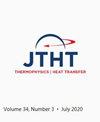微重力混合过程中射流-气液相互作用的计算流体动力学分析
IF 1.7
4区 工程技术
Q4 ENGINEERING, MECHANICAL
引用次数: 0
摘要
在微重力条件下低温储罐的主动压力控制中,有和没有冷却的强制射流混合一直被提出。本文建立了一个三维两相计算流体动力学(CFD)模型,用于描述失重条件下强制液体射流与空腔界面之间复杂的动力学相互作用。根据罐体压力控制实验的微重力结果对CFD模型进行了验证。在微重力实验的射流混合模拟中,采用流体体积法捕捉了射流的变形和运动。考虑了两种不同的初始ulage位置,并将射流- ulage相互作用的计算结果与从实验实时视频中捕获的静止图像序列进行了比较。在射流韦伯数范围内的参数模拟表明,从非穿透到完全穿透的四种不同的射流-射流相互作用模式得到了实验证实。定性比较也提供了CFD预测和实验结果之间很好的一致性,关于ulage动力学的主要特征,如微重力混合过程中的运动、变形和射流穿透。本文章由计算机程序翻译,如有差异,请以英文原文为准。
Computational Fluid Dynamics Analysis of Jet-Ullage Interactions During Microgravity Mixing
Forced jet mixing with and without cooling has long been proposed for active pressure control of cryogenic tanks in microgravity. In this paper, a three-dimensional two-phase computational fluid dynamics (CFD) model is presented that was developed to capture the intricate dynamic interaction between a forced liquid jet and the ullage interface under weightlessness conditions. The CFD model is validated against the microgravity results of the Tank Pressure Control Experiment. The volume-of-fluid method is used to capture the ullage deformation as well as movement in the jet mixing simulations of the microgravity experiment. Two different initial ullage positions are considered, and computational results for the jet–ullage interaction are compared with a still-image sequence captured from real-time video of the experiment. Parametric simulations over a range of jet Weber numbers indicate four distinct jet–ullage interaction modes from nonpenetrating to fully penetrating, which are corroborated experimentally. Qualitative comparisons also provide good agreement between CFD predictions and experimental results with regard to the main features of the ullage dynamics, such as movement, deformation, and jet penetration during microgravity mixing.
求助全文
通过发布文献求助,成功后即可免费获取论文全文。
去求助
来源期刊

Journal of Thermophysics and Heat Transfer
工程技术-工程:机械
CiteScore
3.50
自引率
19.00%
发文量
95
审稿时长
3 months
期刊介绍:
This Journal is devoted to the advancement of the science and technology of thermophysics and heat transfer through the dissemination of original research papers disclosing new technical knowledge and exploratory developments and applications based on new knowledge. The Journal publishes qualified papers that deal with the properties and mechanisms involved in thermal energy transfer and storage in gases, liquids, and solids or combinations thereof. These studies include aerothermodynamics; conductive, convective, radiative, and multiphase modes of heat transfer; micro- and nano-scale heat transfer; nonintrusive diagnostics; numerical and experimental techniques; plasma excitation and flow interactions; thermal systems; and thermophysical properties. Papers that review recent research developments in any of the prior topics are also solicited.
 求助内容:
求助内容: 应助结果提醒方式:
应助结果提醒方式:


